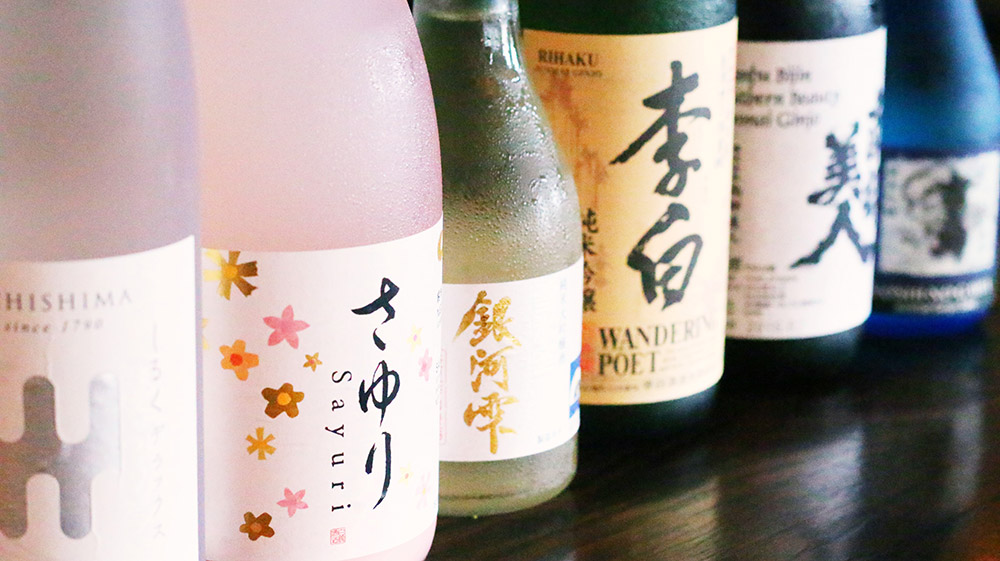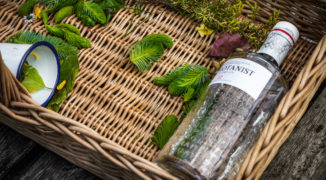For purists, the thought of blending sake with other ingredients is nothing short of blasphemous. But for bartenders and sake enthusiasts adventurous enough to try something new, sake makes a brilliant addition to cocktails. Whether as the central character or a supporting player, sake’s unique umami flavor offers a cocktail experience unlike any you’ve ever had. Despite its complexity, sake is a very approachable ingredient that can breathe new life into your creations.
Rich with history and culture, sake is a drink just as diverse and complex as wine. Made from rice, koji (Japanese yeast) and water, sake is a fermented drink that’s existed in some form for well over a thousand years. There are myriad styles, varieties and flavors to choose from, all ranging in quality based on the percentage of rice that gets milled away during the brewing process. Sake can come filtered, partially unfiltered (nigori), partially unpasteurized (nama) or with added alcohol in the brewing process (honjozo). As with wine, the world of sake is vast and complex, but it’s not as intimidating as it seems.
Certified Sake Sommelier Ty Taylor is a master at crafting sake cocktails. For bartenders who have never worked with sake before, Taylor suggests swapping out vermouth for sake in the classics, using them as a template. He also recommends taking well-balanced cocktail recipes and substituting sake for a spirit with similar weight, like vodka or gin. In his version of a Corpse Reviver #2, called the Aokigahara #2, Taylor combines equal parts gin, Cointreau and Funaguchi Gold (a nama sake) with fresh lemon juice for a compelling, refreshing take on an old standby.
As for what kind of sake to use, Taylor cautions against using high-end varieties like Junmai Daiginjo, the best grade of sake, in cocktails for two reasons. “The flavors, aromas and weight of the sake are often too subtle to properly integrate, and to overcome this, one is tempted to add more of the Junmai Daiginjo to really resonate in the drink,” often causing the price of the resulting cocktail to skyrocket. Instead, he recommends using namas, the unpasteurized variety. “They are … bright, bold and fresh … [and] much more likely to balance well with ingredients in a cocktail without getting lost in the mix.” Taylor notes that there is a place for higher quality sake like Daiginjo and Ginjo in cocktail crafting though. “When not being mixed with the dominant flavors from other spirits, the delicate and aromatic nature of a higher grade sake can still shine through.”
A recent trend behind the bar is crafting low alcohol by volume (ABV) drinks with vermouth, amaro, or wine instead of high-proof spirits. Many guests love low-ABV cocktails, as they have a more mellow effect than full-strength drinks. Low-ABV cocktails also appeal to patrons who have a low tolerance for alcohol or who don’t necessarily love the boozy flavor of strong drinks. Sake is another ideal ingredient for these low-ABV concoctions. Daiginjo or Ginjo sake make excellent cocktails, as their central flavors can easily play the lead.
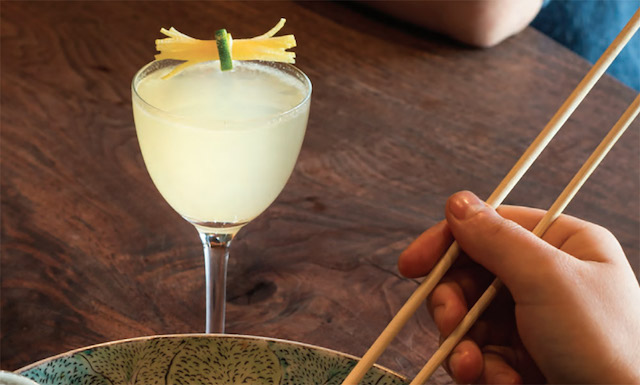 The Joto Gimlet is one way to incorporate sake into the classics for a unique expression of a traditional cocktail. Photo by Dina Avila.
The Joto Gimlet is one way to incorporate sake into the classics for a unique expression of a traditional cocktail. Photo by Dina Avila.
One company making waves in the sake cocktail community is Joto Sake, who partnered with bartender Kyle Linden Webster of Portland’s Expatriate bar to shape their sake cocktail guide, which fuses Joto’s high quality sakes with craft ingredients to create sophisticated and approachable sake cocktails. They have cocktails in many bars and restaurants across the country, notably The Pines in Brooklyn and several Friedman’s locations in Manhattan. Joto’s signature drink is the Joto Gimlet, a low ABV cocktail which blends three ounces of Joto Daiginjo with fresh lime juice, simple syrup and yuzu for a refreshing, umami-heavy drink.
According to Joto’s President Henry Sidel, “craft cocktails open up the world of sake even further.” And he’s right. Cocktails are a great way to introduce people to sake who might not try it otherwise. But there are other advantages as well. As Joto Sales Manager Ryan Mellinger explains, “sake offers low ABV alternatives for restaurants who can’t serve liquor,” which is an excellent advantage for establishments who don’t have a full liquor license.rn
Mellinger adds that sake also works wonders in full-strength cocktails. She recommends pairing sake with herbal and botanical spirits, as the grassy, melon-y flavors of sake complement everything from gin to Cynar to Chartreuse. “I’ve talked with other bartenders who even use a tiny amount of sake, not even as a main ingredient listed in the drink, to ‘round out’ the flavors and ‘ground’ the drink overall, hitting other parts of the palate.”
I have certainly found that to be true in my own experience working with sake. Behind the bar at O-Ku in Atlanta, I’ve created a handful of cocktails using many different kinds of sake. Currently featured on our seasonal menu is the Moment of Zen, a filtered sake drink with gin and a touch of grapefruit, agave and muddled cucumber and mint. Though sake is the central ingredient, it plays a supportive role in the drink, emulsifying the flavors for a rich, silken texture with notes of round coconut and refreshing melon. When using sake, I consider balance above all else. If a sake is acidic, I avoid blending it with additional acid like citrus or a shrub. Likewise, creamy nigori has a natural sweetness to it that pairs best with lighter ingredients like dry vermouth or gin.
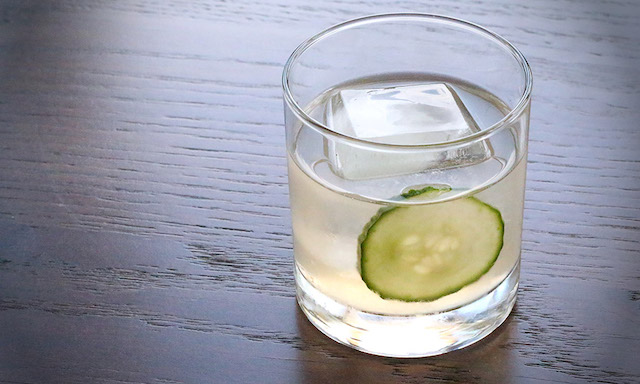 Large ice cubes are ideal for sake cocktails served on the rocks, as they slow the dilution rate. Photo by Amber Thornton.
Large ice cubes are ideal for sake cocktails served on the rocks, as they slow the dilution rate. Photo by Amber Thornton.
Atlanta bartender Tiffanie Barriere uses this exact contrast in her highly praised 007-inspired sake cocktail You Only Live Twice, which she calls a Japanese-style Vesper. Composed of equal parts shochu, dry vermouth and nigori with half an ounce of rosemary syrup, her drink is the perfect nigori cocktail, boozy but delicate, smooth but robust. Barriere offers up an additional pointer for working with sake: “Light is bright when it comes to sake,” she says, recommending clear spirits and floral flavors for pairings.
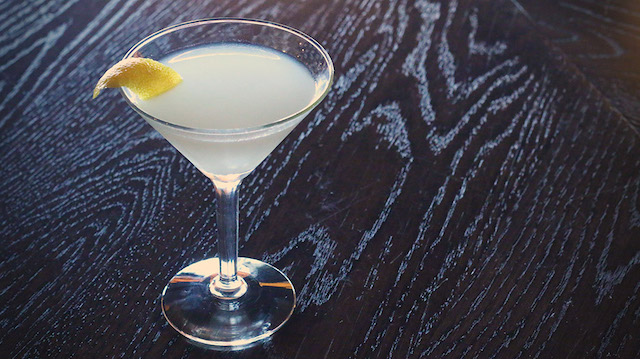 You Only Live Twice is named after one of Barriere’s favorite James Bond films. Photo by Amber Thornton.
You Only Live Twice is named after one of Barriere’s favorite James Bond films. Photo by Amber Thornton.
Another notable player in the sake cocktail community is Kenta Goto, owner of Bar Goto in New York City. His bar program features two sake cocktails, the Far East Side, which combines sake with a touch of tequila, elderflower liqueur, shiso leaf and yuzu. The other, Goto’s personal favorite, is the Sakura Martini, a blend of sake, gin, and maraschino liqueur, garnished with a salted cherry blossom.
Before Bar Goto, solid sake cocktails in New York City were few and far between. “That’s what made me want to put sake cocktails on the menu,” he says, noting that there are three elements every bartender should consider when working with sake: flavor, proof and temperature. With such a delicate flavor, Goto warns not to overpower sake with many other ingredients. “Keep it simple to let the flavor shine.” He cautions against diluting it too much with ice or juice, driving the proof even further down. His solution? Temperature. “Keep sake as cold as possible so that ice won’t melt too quickly when mixing.”
Ultimately, sake adds flavors and textures that can’t be achieved with any other ingredients. Its unique umami quality can elevate a cocktail, allowing bartenders to experiment with new flavor combinations for new twists on old standbys and entirely new concoctions altogether. Sake is on the rise in America, and cocktails are just one way it’s becoming a staple behind the bar.


